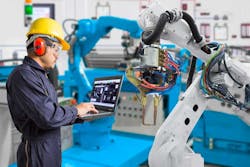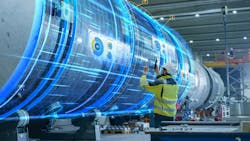Industry 4.0 and Digital Transformation is a global trend. This trend will have an impact on machines of all types and is creating the opportunity for "smarter" machines.
Today, industry is dominated by legacy machines that are performing their functions as designed and delivered. Developed by OEMs, they run at the speeds, quality, and reliability that they were initially designed for. When they require routine maintenance, it is generally done on a schedule, to avoid maintenance at the point of failure. That maintenance is performed by on-site personnel. Machines of this type perform their functions, but with little opportunity for improvement.
Industry 4.0 refers to the intelligent networking of machines and processes for industry with the help of information and communication technology. There are many ways for companies to use intelligent networking.
Monitoring Products with Digital Networking
Many companies are involved in a step-by-step process to develop and manufacture a product. In being digitally networked, these steps can be better coordinated, and the machine load better planned.
Future production lines can be built in modules and be quickly assembled for tasks. Productivity and efficiency would be improved; individualized products can be produced in small quantities at affordable prices.
Consumers and producers will move closer together. The customers themselves could design products according to their wishes—for example, sneakers designed and tailored to the customer’s unique foot shape. At the same time, smart products that are already being delivered and in use can send data to the manufacturer. With this usage data, the manufacturer can improve his or her products and offer the customer novel services.
Data on the production process and the condition of a product will be combined and analyzed. Data analysis provides guidance on how to make a product more efficiently. More importantly, it's the foundation for completely new business models and services. For example, lift manufacturers can offer their customers "predictive maintenance": elevators equipped with sensors that continuously send data about their condition. Product wear would be detected and corrected before it leads to an elevator system failure.
The entire lifecycle of a product can be considered with the support of data. The design phase would already be able to determine which materials can be recycled.
Data Convergence and Industry 4.0 for Machine Builders
Today, there is a better way, a way brought about through the data convergence fostered by the Industry 4.0 trend. Industry 4.0 is about leveraging new technologies for the benefit of continuous improvement. While there are close to a dozen Industry 4.0 technologies to leverage such as additive manufacturing and augmented reality, the technologies most related to machine operation would include IIoT (the Industrial Internet of Things), Internet, Cloud, and Artificial Intelligence (AI).
The latter Industry 4.0 technologies are delivering the opportunity for smarter machines, machines that can be monitored and automatically analyzed for performance, quality, and reliability, offering the ability to operate or tune the machine to maximize KPIs to benefit the user.
Designing a smarter machine requires attention to the following:
- Providing external access to all existing machine variables
- Instrumenting a machine with additional sensors to enable greater context and understanding of operation
- Adding new capabilities to deliver a competitive advantage
Each of these three topics is explained in depth below. Considering machine access, utilization of sensors, and adding capabilities provides machine builders better feedback and a better product in the long run.
Provide External Access to All Machine Variables
In the past, external machine access has been one of the greatest challenges, primarily because communications within a machine fall into various categories and have differing requirements. There is typically a control network and a supervisory network. And there can be a bridge to an external network. Some communications require deterministic performance for processes such as motion control, or high reliability for safety. Other communications are less demanding and are for informational purposes.
Often, the gateway for these communications becomes the controller – PLC, or the operator interface. Ideally, there should be a common backbone for all machine communications. The most common backbone for IT communications is Ethernet. The improvement in Ethernet performance is greatly outpacing that of the niche industrial transports based on the needs of a much larger IT market.
In 2016, Ethernet specifications were expanded to include Time Sensitive Networking (TSN). This was the missing link to enable Ethernet as the complete backbone for machine automation, combining Information Technology (IT) networks and Operational Technology (OT) networks, the combining of control and information communications within a machine. With new products on the market with support for TSN, machine builders can now deliver machines with a common Ethernet TSN backbone, enabling direct data access with the entire machine, from controller to sensors and actuators.
READ MORE: What’s the Difference Between Industrial IoT and Industry 4.0?
Instrumenting Machines with Additional Sensors to Enable Greater Context of Operation
Greater access to machine data means the opportunity to better understand the machine operation, provided there is enough context to enable an understanding of the data. For example, a piece of equipment may be running hotter than usual because it is running harder, under greater load, or because the ambient temperature is higher that day. Startup performance will vary based on a cold start or a warm start.
If your machine isn’t properly instrumented for context, making sense of your data will be more challenging. This also requires a loosening of alarm levels, the early warning system to machine failures. A common backbone will enable the introduction of many more sensors, perhaps completely unrelated to the actual operation of the machine, but critical to understand the context of your machine’s operation, to benefit future analysis.
Adding New Capabilities That Can Deliver a Competitive Advantage
As a machine user, your competitive advantage is your product, making it as efficient and of the highest quality. A Smarter Machine will certainly help. But as a machine builder, what is your competitive advantage?
In an Industry 4.0 world, your competitive advantage may very well be in the machine analytics that you can provide. Are you scheduling maintenance based on operations, or a scheduled timespan? Are you able to view similar machines and identify which will provide the best rate of return, and schedule appropriately? Are you able to connect remotely and have access to enough data, and context, to properly troubleshoot a machine, and eliminate the need for travel and coordinated visits? Can you add new sensors that unlock a greater understanding to the operation of your machine, when needed, installing, or accessing video cameras, for example? Are you delivering Digital Twin analytics, modeling machine operations and dynamically adjusting alarm levels based on the current context of operation?
In Summary
Industry 4.0 technologies are unleashing a new wave of innovation that is sure to increase performance, improve quality and reduce costs. With new technology such as Ethernet TSN, we will see machines shift from their original design for purpose delivery to those that can offer quantified performance, quality, and cost metrics, and that will improve over time, based on OEM analytics and feedback.
This article was written and contributed byThomas Burke, Global Strategic Advisor, CC Link Partner Association (CLPA).
About the Author
Thomas J. Burke
Global Strategic Advisor for the CC Link Partner Association (CLPA)
Thomas J. Burke is Global Strategic Advisor for the CC Link Partner Association (CLPA) which aims to provide collaboration on industrial network connectivity worldwide.
In addition, Tom serves as Global Director of Industry Standards for Mitsubishi Electric to lead the strategic development and adoption of networking standards, including the adoption of Mitsubishi Electric’s open networks solutions. Tom is also the Global Directory of Industry Partnerships for ICONICS, providing leadership to increase market share of ICONICS’ leading-edge product portfolio.
Tom’s background includes being the former OPC Foundation President & Executive Director and pioneered the OPC Unified Architecture (OPC UA) as the foundation of information integration and interoperability.
He has a bachelor’s degree in theoretical mathematics from John Carroll University (Cleveland, OH), and a master’s degree in computer engineering from the University of Dayton (Dayton, OH).

Leaders relevant to this article:





